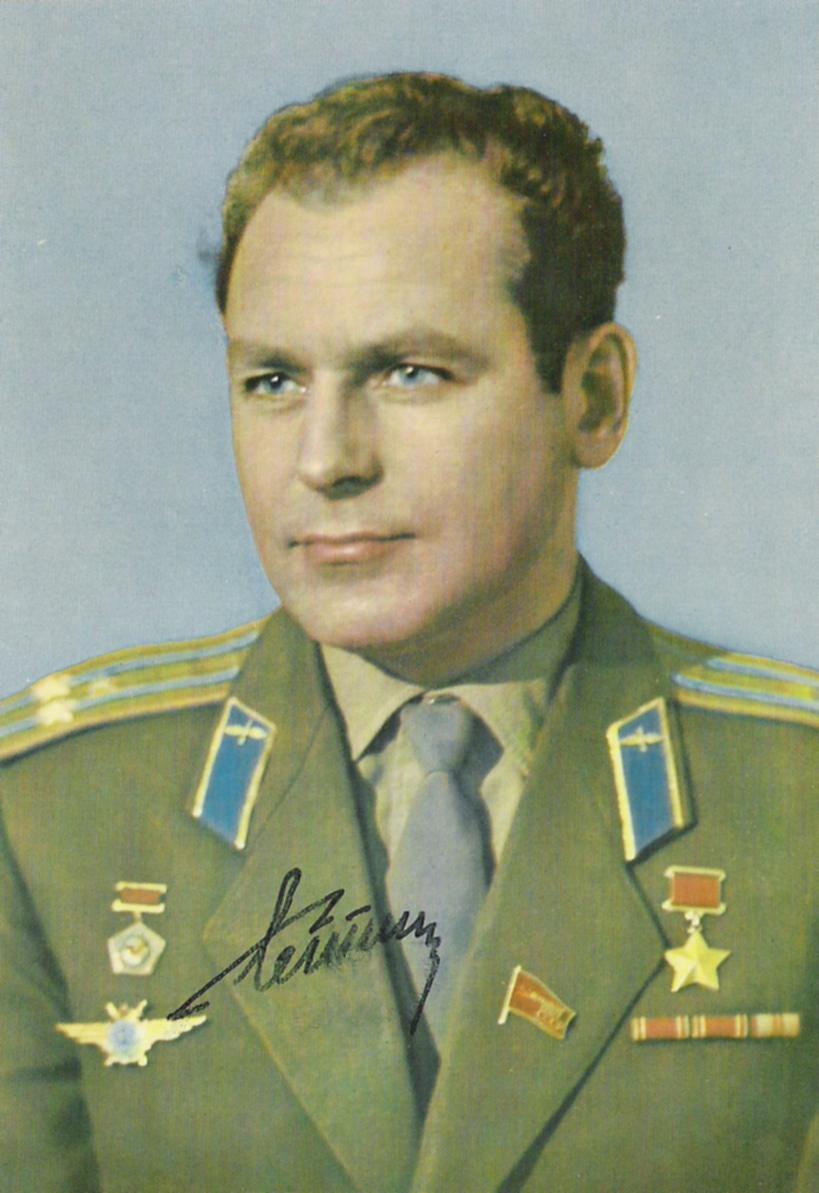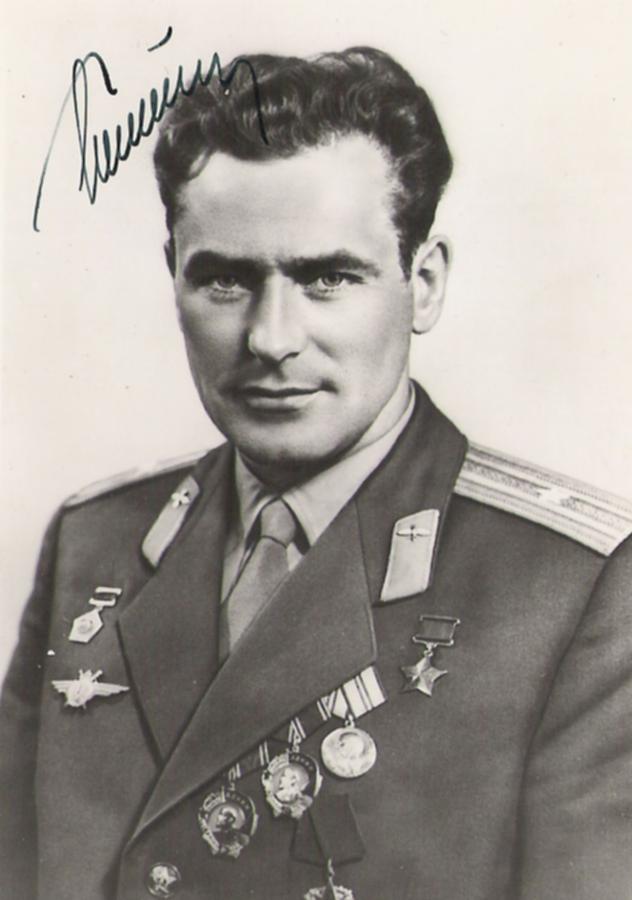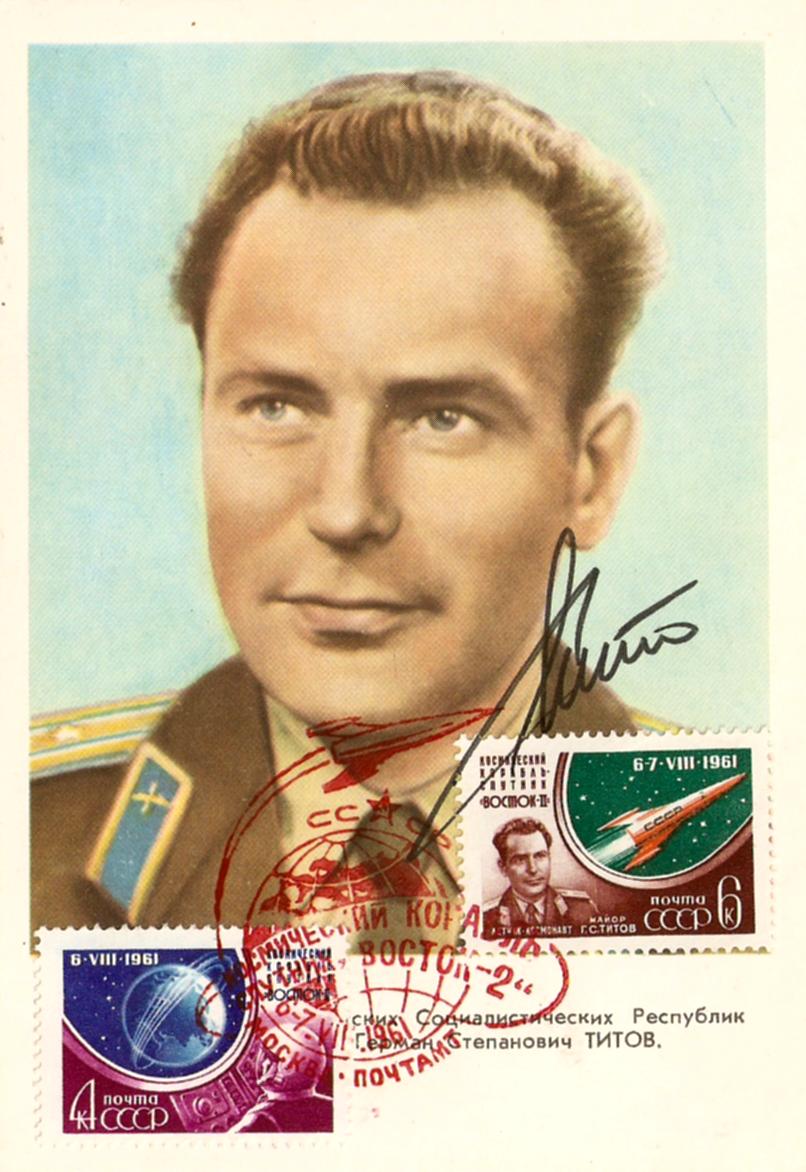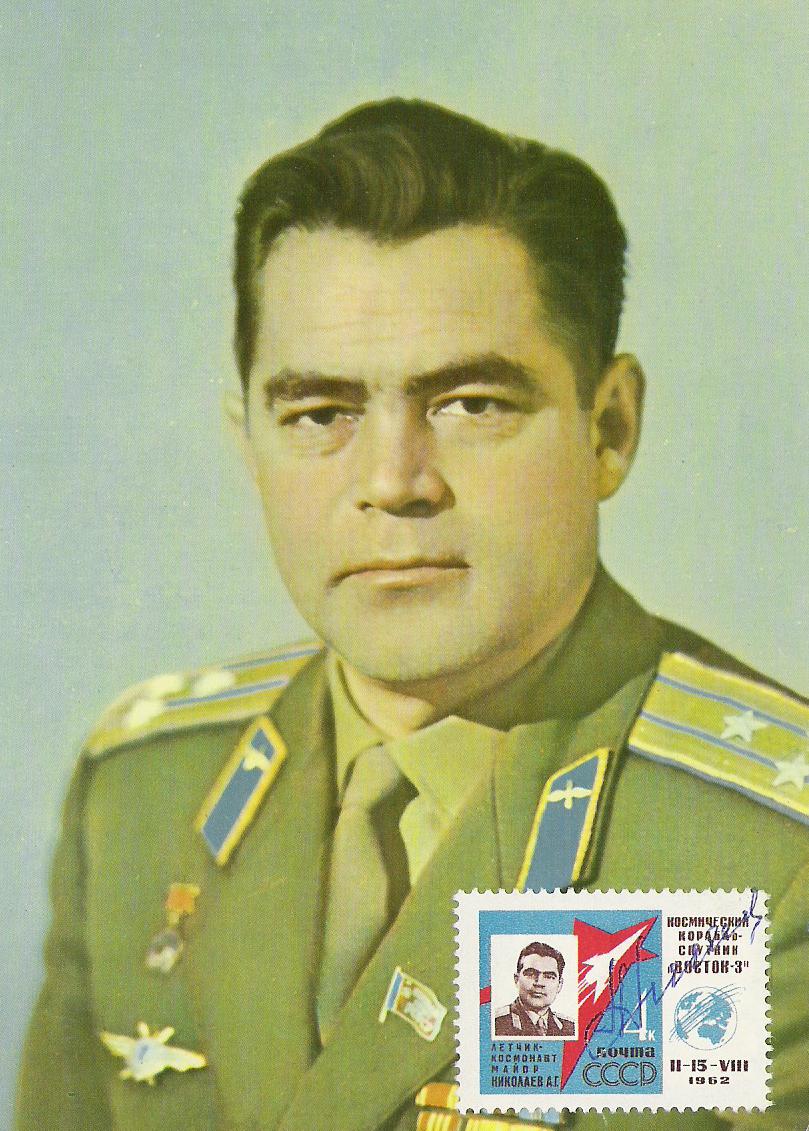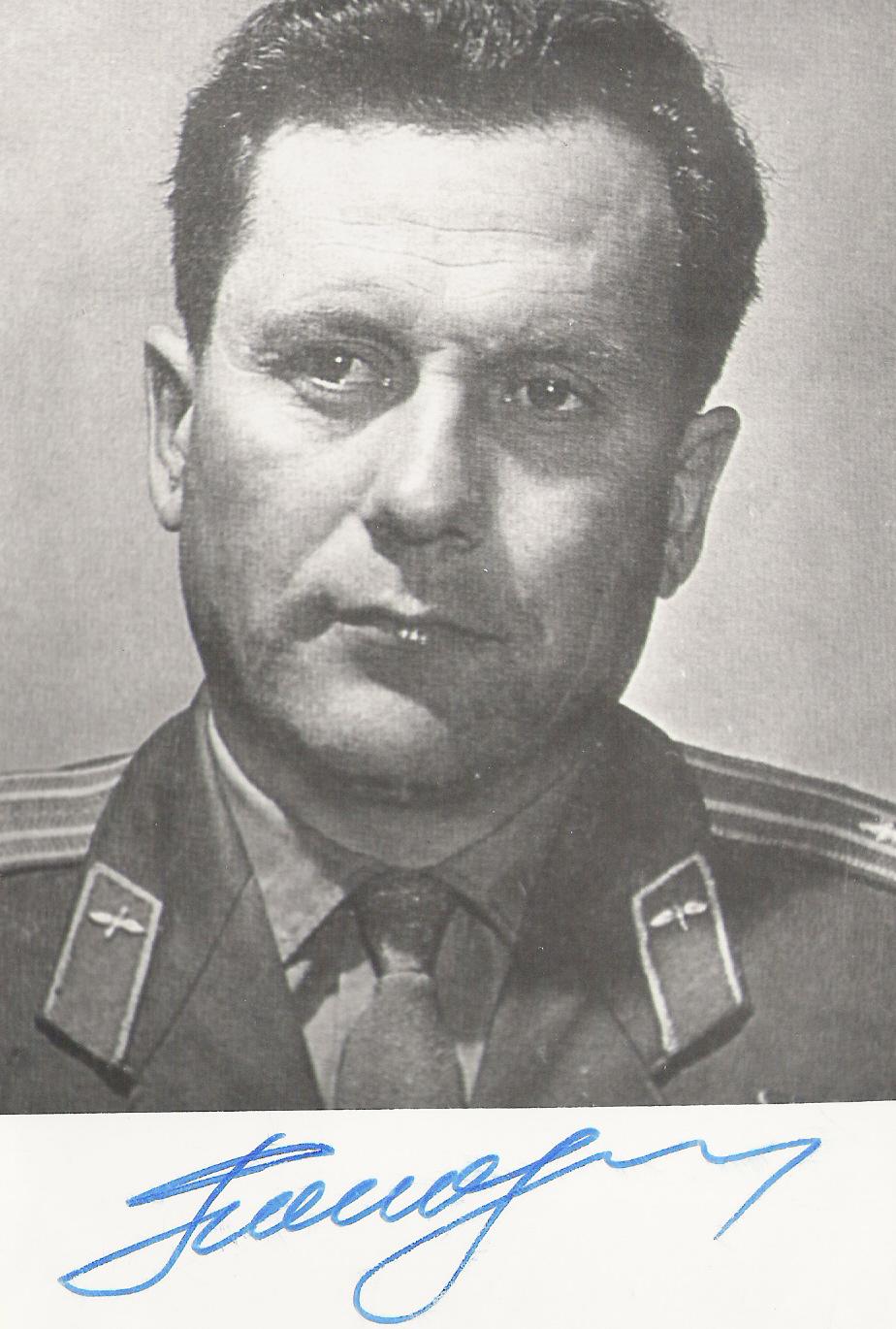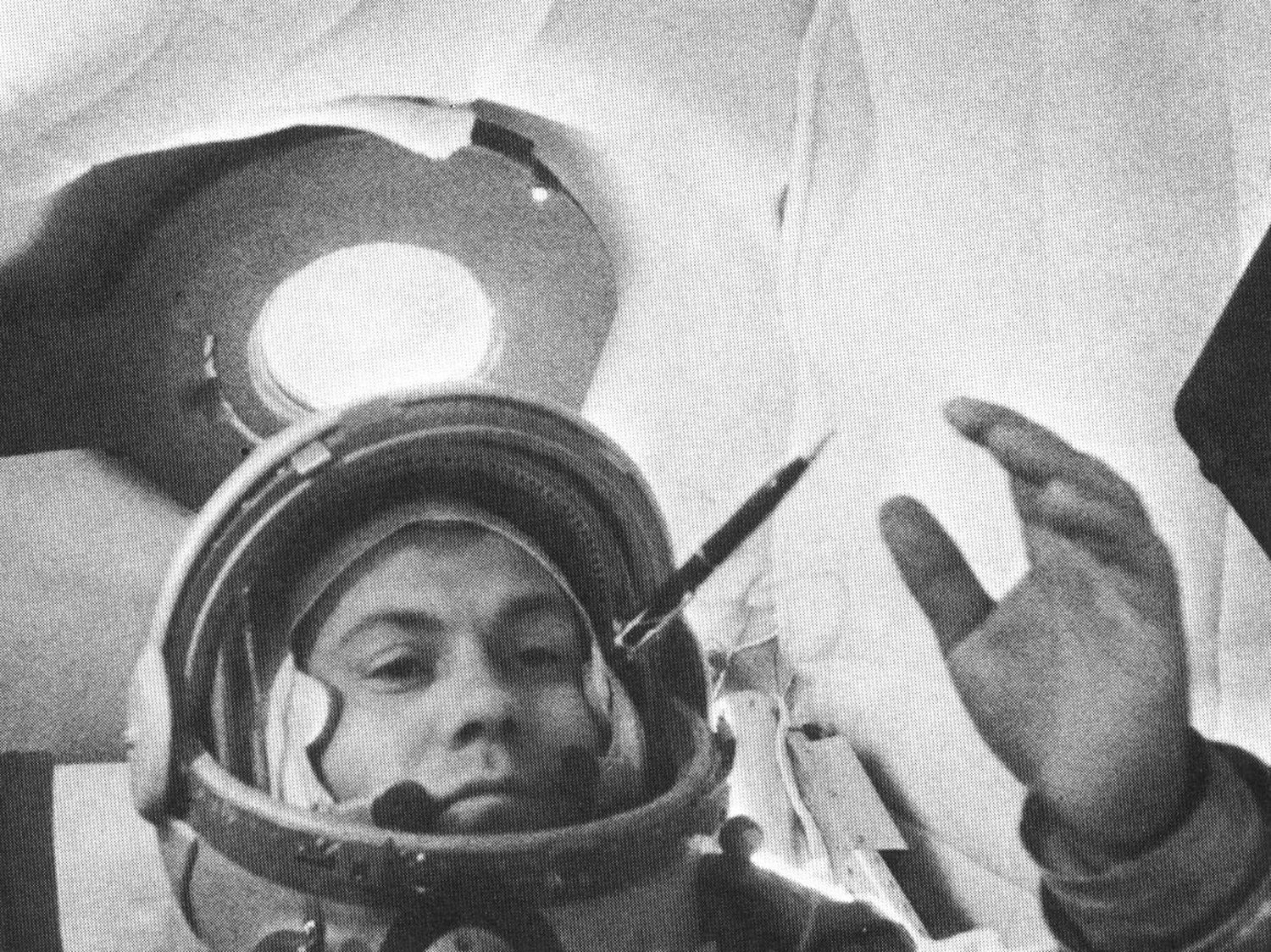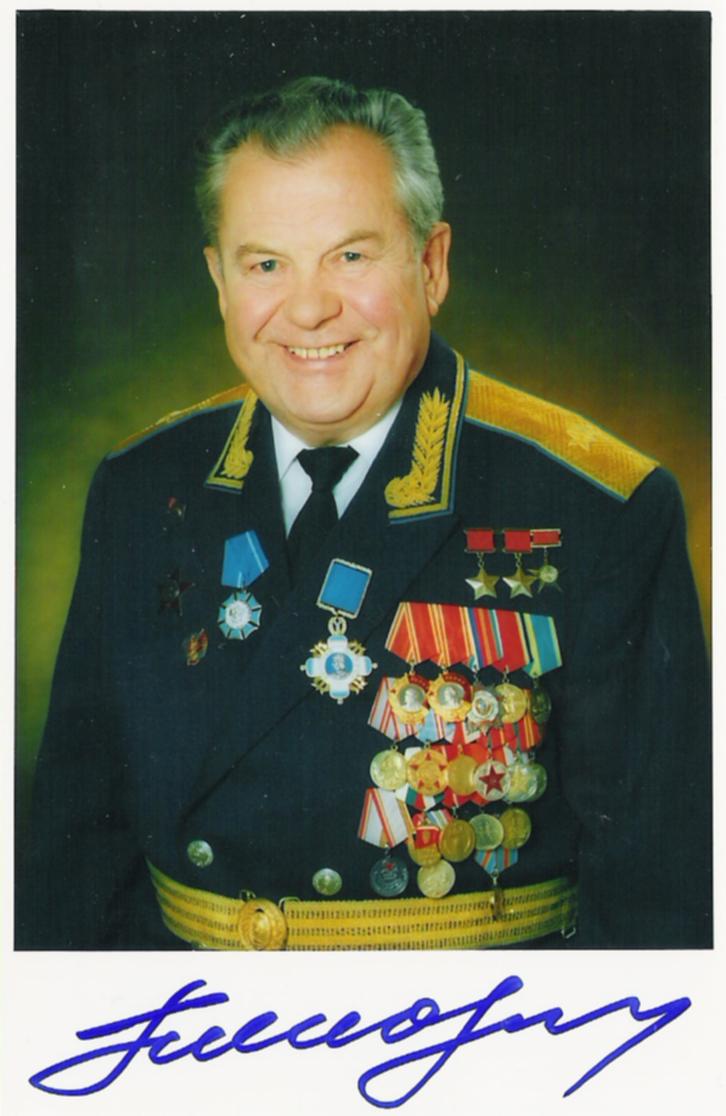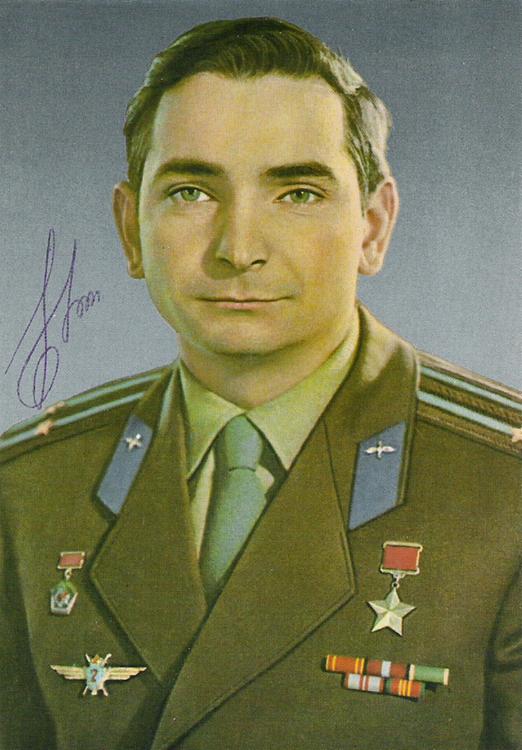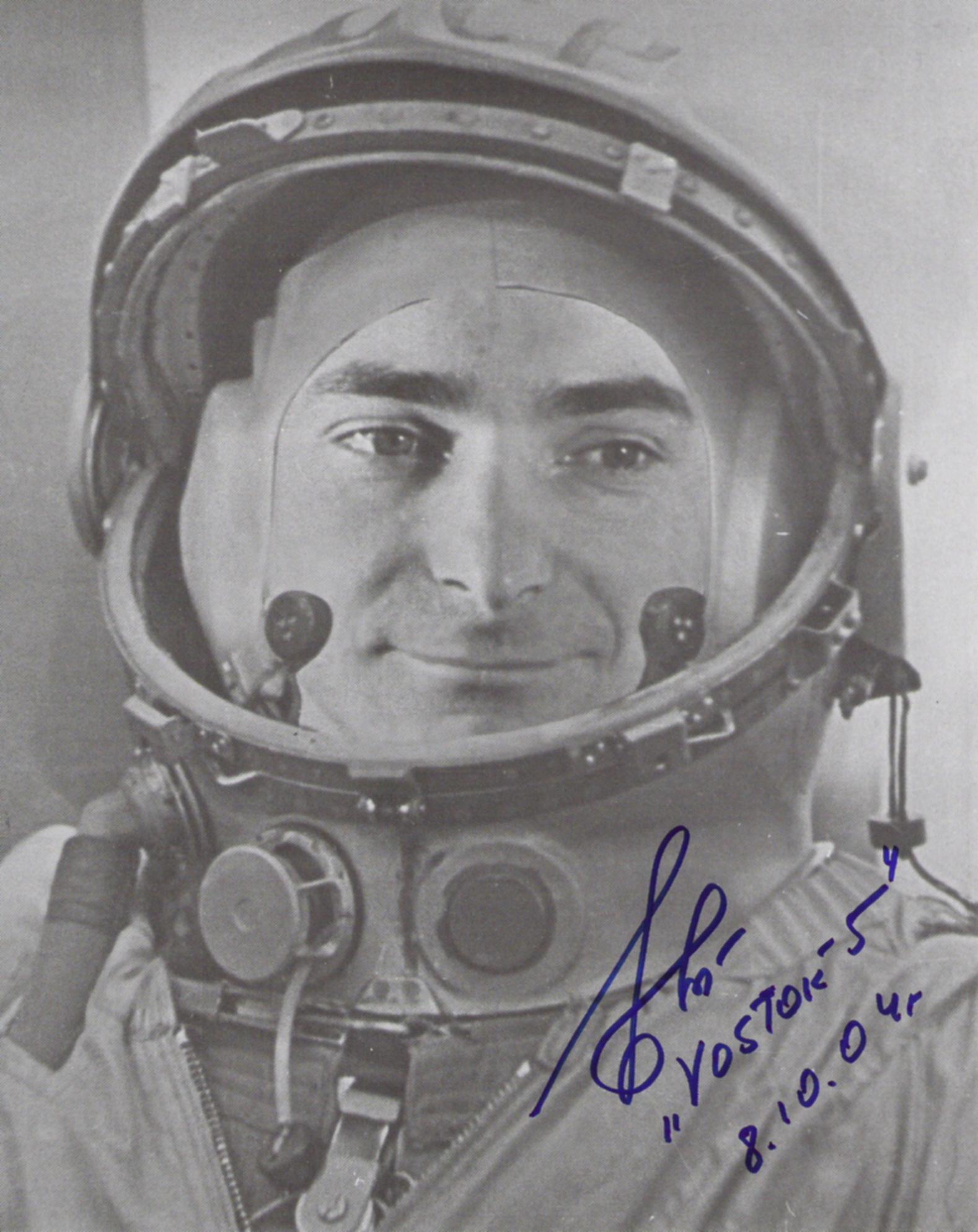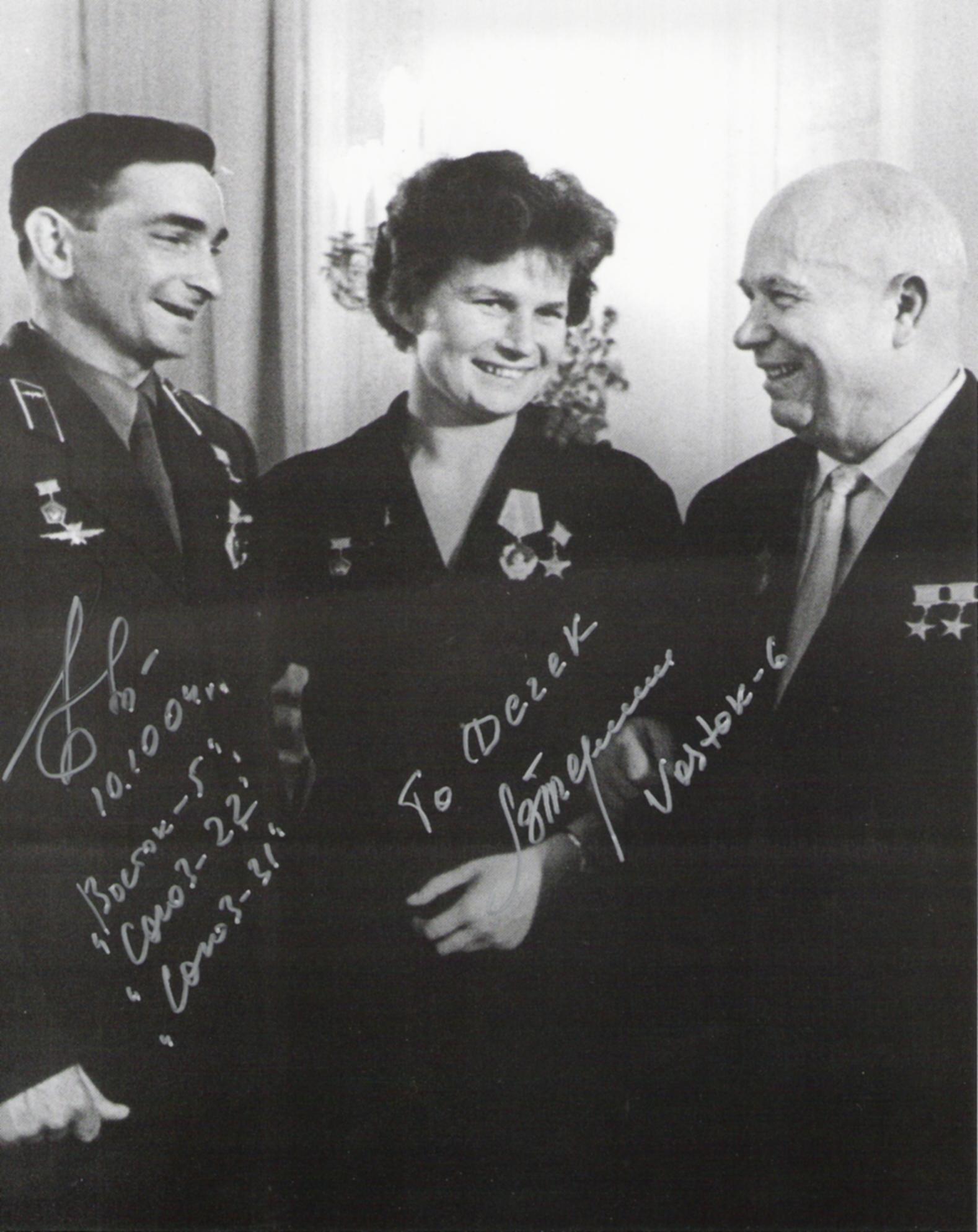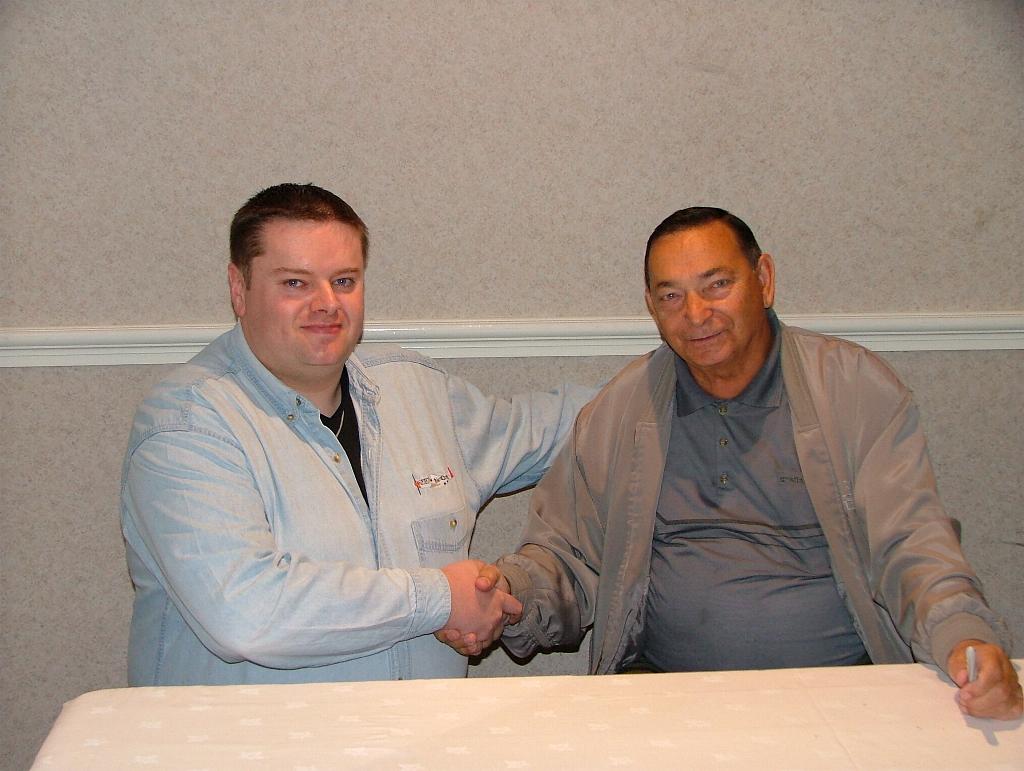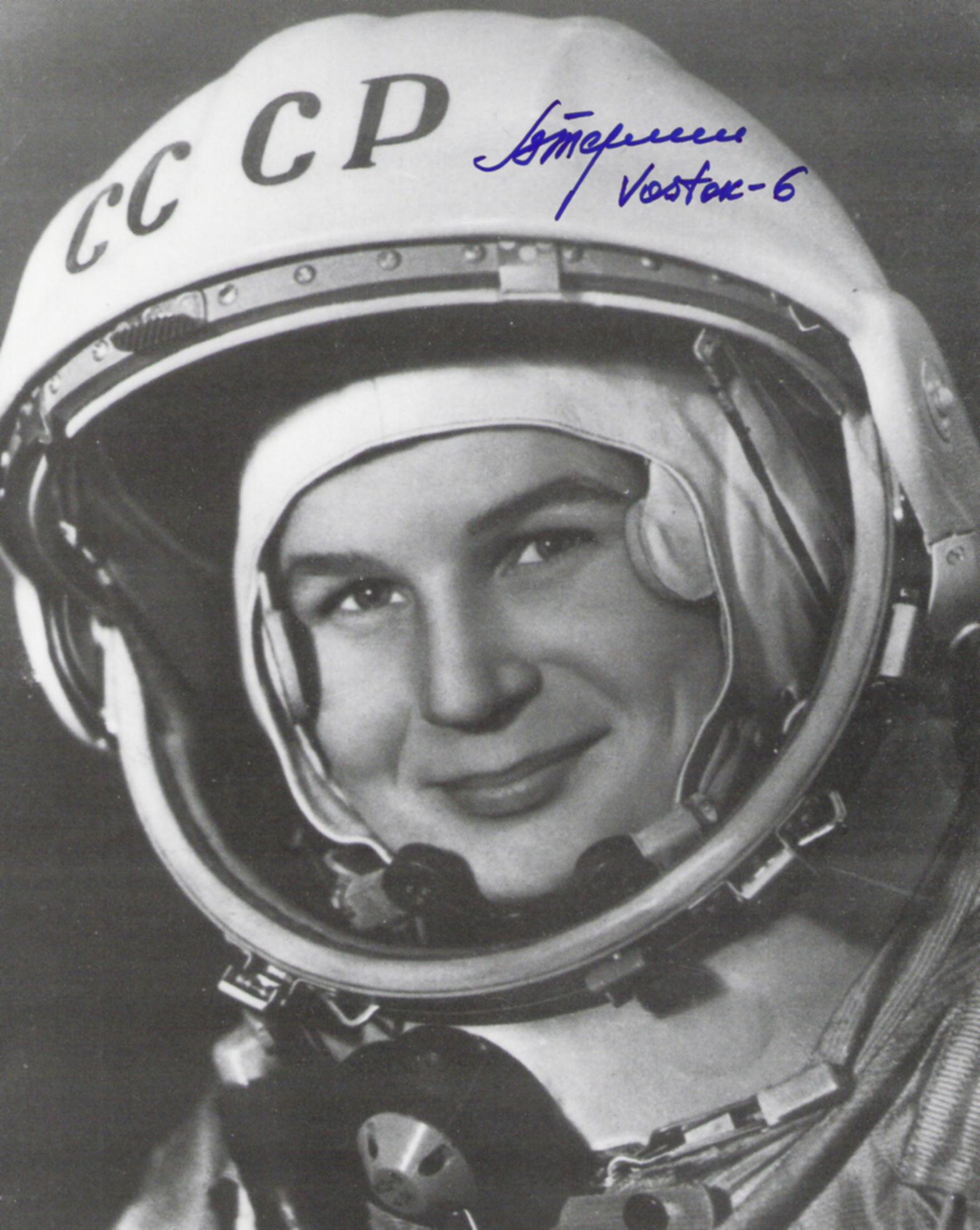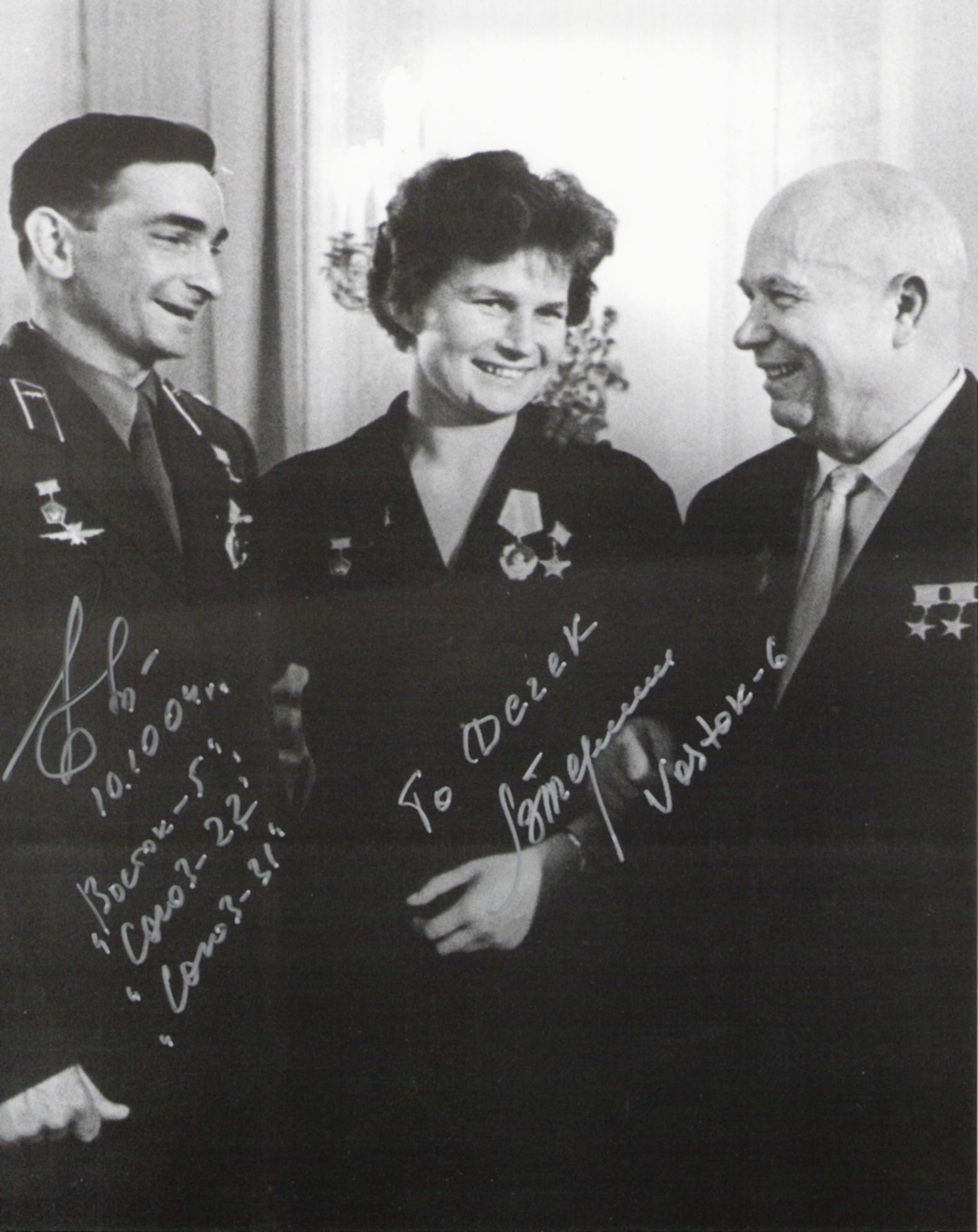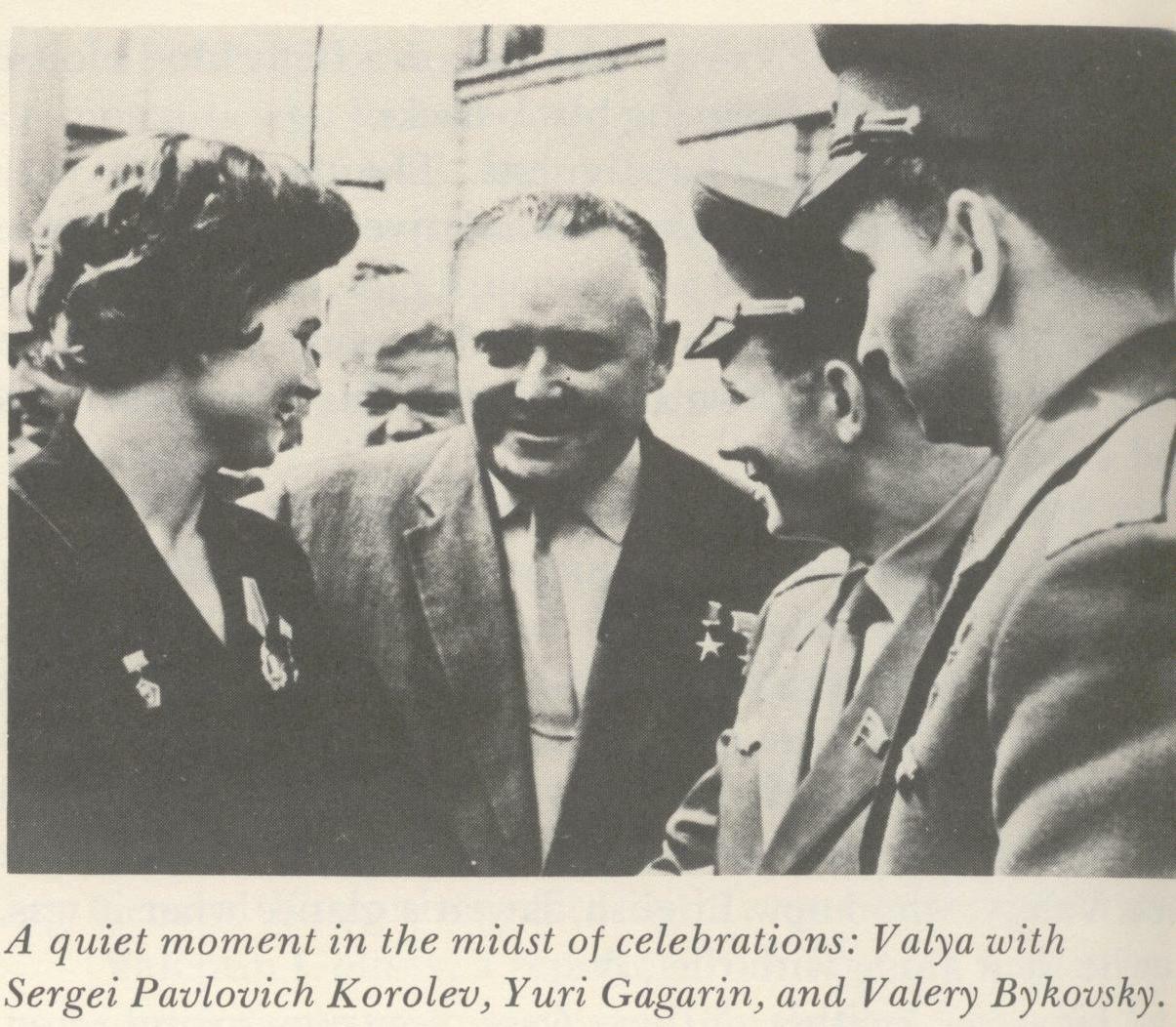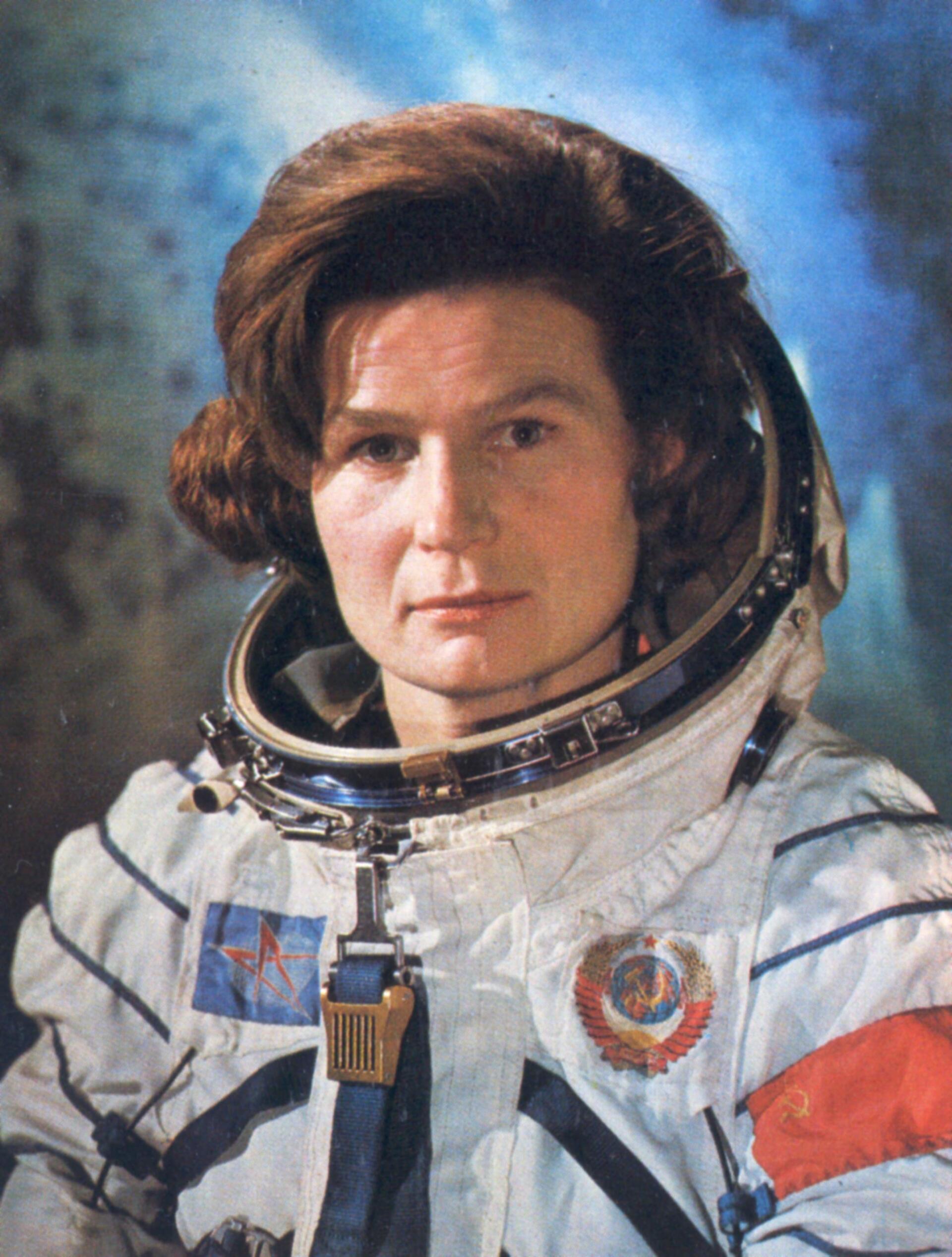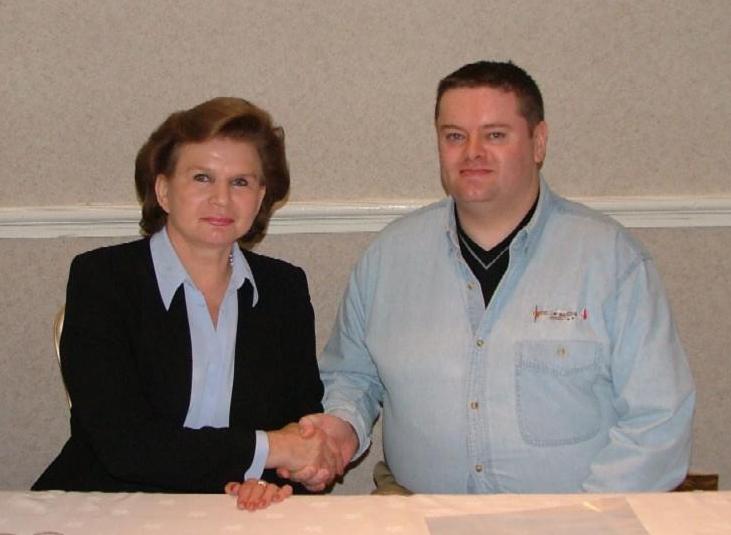Vostok Cosmonauts
Gherman Stepanovich Titov - Vostok 2 - (1935-2000)
Titov completed military aviation training in 1957 and served as an Air Force pilot in the Second Leningrad Aviation Region. In 1960 he was selected in the first cosmonaut group and became the second man to orbit the earth in a one day flight in 1961 aboard Vostok 2 . His boyish good looks and buoyant personality made him a worldwide heart throb after his flight. He liked women, drink, and fast cars, and took full advantage of his celebrity. This resulted in constant trouble with his chain of command over an endless succession of incidents with women and drunk-driving accidents.
With the other flown cosmonauts he entered the Zhukovsky Air Force Engineering Academy in 1962 for formal training as an engineering test pilot. During this period he headed the cosmonaut team training for flight of the Spiral spaceplane. He graduated from Zhukovskiy in 1968 but the chances for future spaceflights seemed slim. He had suffered space sickness on his first flight. This was later found to be common, but in the 1960’s it was held against him. Furthermore it was clear that the Spiral was a dead-end programme that would never fly. Therefore he consciously selected a management career in the Soviet space forces. He graduated from the General Staff Military Academy and was appointed Deputy Chief of the Space Command and Control units in August 1972. From June 1973 he was First Deputy Chief of GUKOS for Research, and First Deputy Commander of GUKOS from 1979 to 1991. In these positions he played a key role in the testing and qualification of numerous military space systems. Titov retired from the military in October 1992. Gherman Titov sadly died on 20th September 2000 from a heart attack.
Andrian Grigoryevich Nikolayev (Vostok 3) - (1929-2004)
Nikolayev completed courses in forestry in at age 18 and then worked in forestry administrative work in Karelia until drafted into the Red Army in 1950. He was identified as a good pilot candidate, and after initial flight training entered the fighter pilot training school in Frunze in August 1951. He completed officer and flight training in 1954 and was assigned to fighter units in the Moscow area. In 1960 he was one of 20 pilots selected in the first group of Soviet cosmonauts. He made the first multi-day spaceflight aboard Vostok 3 in August 1962.
Cosmonaut Commander Kamanin found Nikolayev the calmest of the original cosmonauts, a good chess player, and one of only three cosmonauts kept current in three MiG fighter types. After Valentina Tereshkova's triumphant return from her Vostok 6 flight in June 1963, a joke began circulating that she should marry Nikolayev, the only bachelor cosmonaut to have flown. Although he and Tereshkova did not dislike each other, there was no substance to the rumour of a romance. However the story eventually reached Khrushchev. He saw potential for big propaganda benefits, and began applying pressure through Kamanin, the commander of the cosmonaut detachment, for the couple to marry. They finally gave in and the marriage ceremony took place on November 3, 1963, at the Moscow Wedding Palace, with the wedding party at a governmental mansion set apart for state receptions.
Khrushchev himself presided at the party, together with top government and space program leaders. On June 8, 1964, Tereshkova gave birth to a daughter, Elena Andrianovna, who later went on to become a physician. But the marriage was in trouble almost from the beginning. Tereshkova's in-laws would pressure her to go over Kamanin's head, to higher governmental officials, to complain about Nikolayev's behaviour. Once out of the limelight, the couple would divorce. In 1966-1967 Nikolayev began training for L1 and L3 manned lunar flights. Nikolayev, along with other first group cosmonauts, was assigned to complete engineering graduate courses at the Zhukovsky Test Pilot Engineering Academy. He obtained his degree in December 1968. From February 1968 to 1974 he served as a Deputy Director for Training at the Yuri Gagarin Cosmonaut Training Centre. He supervised cosmonauts training for L1 and L3 lunar, and Soyuz earth-orbit flights. He flew in the record-duration 18-day Soyuz 9 flight in 1970. Nikolayev and his crewmate were in extremely poor physical condition after their flight. In fact, no other crew on a flight of any duration has ever come back in such bad shape. At the time this called into serious question Soviet plans for long-duration space stations. In 1974 Nikolayev was named as First Deputy for Training at the cosmonaut centre, and stayed in that position until his retirement in 1982. This appointment was somewhat ironic since failure to follow the pre-flight and in-flight exercise regime was considered part of the reason for his extremely poor physical condition after Soyuz 9. As a flown cosmonaut, and one that had been aboard two record-breaking flights, Nikolayev received innumerable honours, prizes, medals, and privileges. As a more enduring monument, a prominent lunar crater was named after him. Two books appeared under his name, Vstretimsya na orbite (Meeting in Orbit) and Kosmos - doroga byez kontsa (Space - Road without End). Nikolayev's cosmonaut call sign was Sokol (Falcon).
Pavel Romanovich Popovich (Vostok 4) - (1930-2009)
Pavel Popovich flew aboard Vostok 4 which was a joint flight with Vostok 3. Acquisition of experimental data on the possibility of establishing a direct link between two space ships; coordination of astronauts' operations; study of the effects of identical spaceflight conditions on the human organism. Popovich had problems with his life support system, resulting in the cabin temperature dropping to 10 degrees Centigrade and the humidity to 35%. The cosmonaut still managed to conduct experiments, including taking colour motion pictures of the terminator between night and day and the cabin interior. Despite the conditions, Popovich felt able to go for the full four days scheduled. But before the mission, Popovich had been briefed to tell ground control that he was 'observing thunderstorms' if he felt the motion sickness that had plagued Titov and needed to return on the next opportunity.
Unfortunately he actually did report seeing thunderstorms over the Gulf of Mexico, and ground control took this as a request for an early return. He was ordered down a day early, landing within a few minutes of Nikolayev. Only on the ground was it discovered that he was willing to go the full duration, and that ground control had thought he had given the code. Recovered August 15, 1962 6:59 GMT. Landed 48:09 N 71:51 E.
Popovich was given the code phrase 'observing thunderstorms' to be used if he felt severe motion sickness and needed to return on the next opportunity. Unfortunately he actually did report seeing thunderstorms over the Gulf of Mexico, and ground control took this as a request for an early return, causing a scramble before the misunderstanding was cleared up. Pavel Popovich sadly passed away on 29th September 2009, he was 78 years old.
Valeri Fyodorovich Bykovsky (Vostok 5) - (1934-2019)
Valeri Fyodorovich Bykovsky was born on August 2, 1934 in the city of Pavlovsky Posad in the Moscow region. In 1951, he graduated from middle school and entered Kachinsk's Myasnikov High Aviation School. After graduation in 1955, he served with the Soviet Air Force. In 1960 he was accepted into the Soviet cosmonaut unit (1960 Air Force Group # 1). He underwent the full general space preparation course and trained for space flight on Vostok type spacecraft. In August 1962 he was the reserve crew member for the Vostok-3 flight. He performed his first flight on August 14-16, 1963, as commander of the space ship Vostok-5 (call sign - Yastreb). His space flight lasted 4 days 23 hours and 6 minutes. He next trained for the Soviet Lunar program. In April 1967 he was the commander of the reserve crew (together with Aleksey Stanislavovich Yeliseev and Eugene Vasilyevich Khrunov) for the planned Soyuz-2 flight. Because of the problems with Soyuz-1, which culminated in it crashing and killing Vladimir Komarov, the launch of Soyuz-2 was cancelled.
Bykovsky made his second space flight on September 15-23, 1976, as commander of the space ship Soyuz-22 (call sign - Yastreb-1) together with Vladimir Viktorovich Aksenov. Their stay in space was 7 days 21 hours 52 minutes and 17 seconds. From 1977 Bykovsky underwent preparations under the Intercosmos program for co-operation with socialist countries. He made his third space flight from August 26 through September 3, 1978, as commander of the space ship Soyuz-31 (call sign - Yastreb-1) together with German Sigmund Jaehn. The cosmonauts worked onboard the orbital complex Salyut-6 - Soyuz-29 - Soyuz-30 together with Vladimir Vasilyevich Kovalenok and Alexsander Sergeyevich Ivanchenkov. Their stay in space was 7 days 20 hours 49 minutes and 4 seconds. During his three flights Bykovsky spent 20 days 17 hours 47 minutes and 21 seconds in space. In July 1980 he was the commander of the reserve crew (together with the Vietnamese Byi Thai Liem) for the Soyuz-37 flight. In 1988 he left the cosmonaut team. Bykovsky was Director of House of Soviet Science and Culture in Berlin from 1989 to 1991. He is currently retired. Twice awarded the title Hero of the Soviet Union. Hero of the Socialist Republic of Vietnam. Hero of the People's Republic of Bulgaria. Hero of the German Democratic Republic. Awarded three Orders of Lenin, Order of Red Star, Order of Karl Marx (GDR), Order Krest Grunvald (Poland), Order of Star (Indonesia), Tsiolkovskiy Gold Medal (USSR Academy of Sciences), Lavo Gold Medal (FAI). Honorary citizen of Kaluga, Rzev (Russia), Burgas, Varna (Bulgaria) and Seradz (Poland). I had the pleasure of meeting Valery Bykovsky at the Autographica show in Coventry 2004. Valery Bykovsky sadly passed away on 27th March 2019, he was 84 years old.
Colonel-Engineer Valentina Vladimirovna Tereshkova (Vostok 6)
Born March 6, 1937, in Maslennikovo, a small town in the Yaroslavl Region. Valentina's father, a tractor driver, was killed in action during World War II. Her mother, Elena Fedorovna, worked in a textile plant. Valentina began school in 1945 in Yaroslavl at the age of eight. In 1953 she left school and began working, but continued her education by correspondence course. By 1961 she had earned the certification of graduate cotton-spinning technology expert. Valentina was interested in parachute jumping from an early age and it was this interest that led to her career. She made her first jump under the auspices of the local Aviation Club in Yaroslavl at age 22 on 21 May 1959. Thereafter she set up the Textile Mill Workers Parachute Club and became its first head. Two years later she became secretary of the local Komsomol (Young Communist League). She joined the Communist Party of the Soviet Union after her cosmonaut selection in 1962.
She was one of five women selected as cosmonaut-candidates on February 16, 1962. All five underwent the complete course of training, including weightless flights, parachute jumps, isolation tests, and centrifuge tests. While she excelled in the physical training, she had more difficulty with rocket theory and spacecraft engineering. The training included 120 parachute jumps and pilot training through jet fighters. Although it was Korolev's idea just after Gagarin's flight to put a woman into space as yet another novelty, Khrushchev himself made the final crew selection. On June 14, 1963, Vostok 5 was launched with cosmonaut Valeri Bykovsky aboard. Two days later, Valentina Tereshkova became the first woman in space aboard Vostok 6. Korolev was unhappy with Tereshkova's performance in orbit and she was not permitted to take manual control of the spacecraft as had been planned. Mishin later claimed she was ‘on the edge of psychological instability’. Whatever the case, Valentina completed three days in space, more than the flight time of all the American astronauts put together. Vostok 5 had been planned for a record eight days in space, but Bykovsky had trouble with his thermal regulation system and ended up landing after five days, only three hours after Vostok 6.
After Valentina’s triumphant return a joke began circulating that she should marry Andrian Nikolayev, the only bachelor cosmonaut to have flown. Although Andrian and Valentina did not dislike each other, there was no substance to the rumour, which eventually reached Khrushchev. He thought it was a great idea and began applying pressure through Kamanin, the commander of the cosmonaut detachment, for the couple to marry. They finally gave in and the marriage ceremony took place on November 3, 1963, at the Moscow Wedding Palace, with the wedding party at a governmental mansion set apart for state receptions. Khrushchev himself presided at the party, together with top government and space program leaders. The celebration was continued at Zvyozdny Township. On June 8, 1964, Valentina gave birth to a daughter, Elena Andrianovna, who later went on to become a physician. But the marriage did not last long - Khrushchev’s "space family" fell apart. Valentina obtained a college level education at the Zhukovskiy Military Air Academy from 1964 to 1969. After her graduation, in October 1969, the female cosmonaut detachment was disbanded. Valentina and her fellow female cosmonauts were not truly integrated into the cosmonaut detachment and considered for flight assignments on an equal basis with the ‘regular’ male cosmonauts.
Throughout the Soviet period flights of women into space were considered only on propaganda purposes. An all-female flight was considered aboard a Voskhod spacecraft in 1965, but this was cancelled after the dangerous nature of this Vostok conversion was shown on the near-disastrous flight of Voskhod 2. It was only in the 1980’s, with impending flights by American women on the space shuttle, that the Soviet government again recruited a new group of woman cosmonauts. Svetlana Savitskaya became the second Russian woman in space in 1982 and 1984. A planned all-female Soyuz flight, planned for Soyuz T-15 on International Women’s Day in 1985, was cancelled due to problems with the Salyut 7 space station. Meanwhile Valentina became a prominent member of the Communist Party and a representative of the Soviet government to numerous international women’s organisations and events. She was a member of the World Peace Council in 1966; a member of the Yarsoslavl Supreme Soviet in 1967; a member of the council of the Union of the Supreme Soviet in 1966-1970 and 1970-1974. Valentina was elected to the presidium of the Supreme Soviet in 1974.
She was the Soviet representative to the UN Conference for the International Women’s Year in Mexico City in 1975. Other honours included the rank of deputy to the Supreme Soviet; membership in the Communist Party of the Soviet Union Central Committee; Vice President of the International Woman’s Democratic Federation; and President of the Soviet-Algerian Friendship Society. After her flight in 1963 she received the Order of Lenin; was honoured as a Hero of the Soviet Union; and received an honorary commission in the Soviet Air Force. Although she never flew again, she became a spokeswoman for the Soviet Union. In this role she received the United Nation Gold Medal of Peace; the Simba International Women’s Movement Award; an additional Order of Lenin; and the Joliot-Curie Gold Medal. I had the honour and privelage of meeting Valentina Tereshkova at the Autographica Show in Coventry in 2004. We had a wonderful coversation about her friend & biographer (and fellow Scot!) Lady Antonella Lothian.

